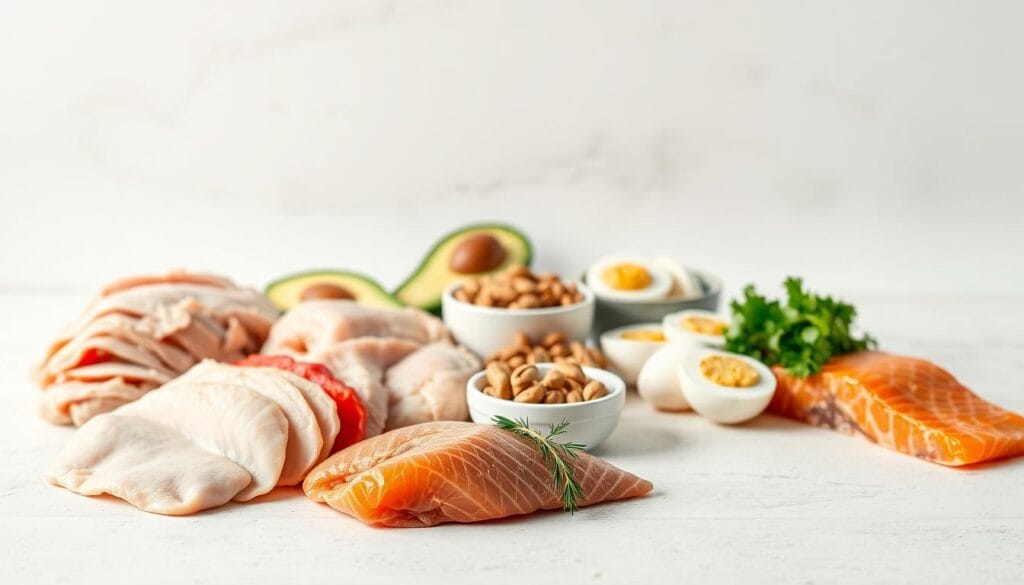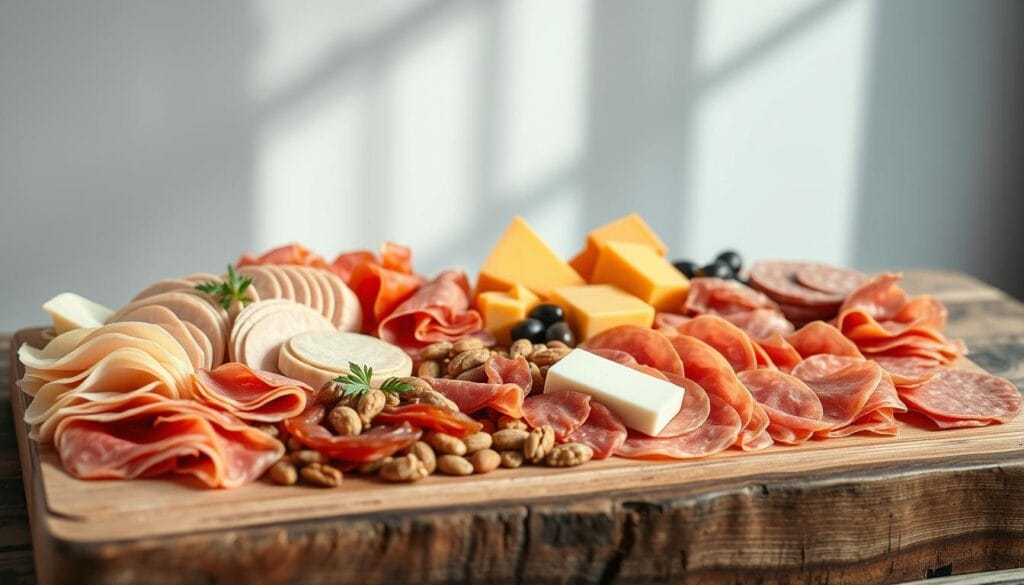Finding the right keto lunch meat is like going on a food adventure. The right low-carb deli meats can make your meals exciting and keep you in ketosis. Your search for the best protein sources begins here.
The ketogenic diet requires careful planning. It needs 70-80% fat, 10-20% protein, and only 5-10% carbs. Choosing the right keto lunch meat is key. Studies show people on personalized diets can lose 9.4 pounds in three months.
Imagine making meals that are both healthy and tasty. Keto lunch meats offer a great mix of convenience and nutrition. They help you stay full and focused on your health goals.
Table of Contents
Understanding the Role of Lunch Meats in Ketogenic Dieting
Choosing zero-carb proteins for a ketogenic diet can be tough. Lunch meats are a smart choice to keep carbs low and meet nutritional needs.
When picking keto diet proteins, balance is key. Experts suggest a daily mix of:
- 70-75% fat
- 20-25% protein
- 5-10% carbohydrates
Macronutrient Requirements for Keto Success
Success on a ketogenic diet depends on the right macronutrient mix. Precision matters in choosing proteins. Lunch meats are a good source of protein without breaking ketosis.
“Not all proteins are created equal in a ketogenic diet” – Nutrition Experts
Why Lunch Meats Fit the Keto Framework
Lunch meats are great for keto dieters. USDA data from April 2019 shows many deli meats, like 96% fat-free ham, are high in protein and low in carbs. They fit well within keto nutritional guidelines.
Daily Protein Needs on Keto
Figuring out your daily protein needs is important. Zero-carb proteins from lunch meats help meet these needs. This way, you avoid gluconeogenesis, a process that could stop ketosis.
By choosing the right lunch meats, you can make a keto meal plan that’s both healthy and enjoyable.
Top Keto Lunch Meat Options for Your Meal Plan
Finding the right keto-friendly cold cuts can be tough. But, picking the right sugar-free lunch meats makes your diet tasty and healthy. Meat and poultry are key for keto fans, offering lots of fat and few carbs.
When picking keto-friendly cold cuts, aim for options that fit your diet goals. Here are some great choices:
- Roast Beef: Offers 18.6g of protein with little fat, great for lean protein
- Turkey: Low-carb and good for many meals
- Chicken: Lean protein with many cooking ways
- Salami: Has more fat, perfect for keto
- Ham: Rich in protein but be mindful of sodium
Choose sugar-free lunch meats by checking labels. Look for simple ingredient lists and 0g sugar. Buying from the deli counter usually means fresher meat than pre-packaged ones.
Nutritional quality is key. Opt for organic or Certified Humane meats for better nutrition. Grass-fed beef, for example, has more vitamins and antioxidants.
Pro tip: More than 10% of Americans eat over a pound of cold cuts a week, so you’re not alone!
Make sure to mix your choices to keep the keto diet’s right balance. Aim for 70% fat, 25% protein, and 5% carbs.
Quality Matters: Choosing Clean Keto Lunch Meat
Choosing the right lunch meats is key for a healthy keto diet. Not all deli meats are the same. Knowing how to pick high-quality, low-carb options is important for your health.
Navigating Hidden Sugars and Fillers
Many processed meats have hidden ingredients that can ruin your keto diet. When looking for high-fat snacks, watch out for these:
- Avoid meats with added sugars
- Watch for chemical preservatives
- Check for hidden carbohydrate sources
Mastering Nutrition Label Reading
Being good at reading nutrition labels helps keep your keto diet on track. Look for these important things:
- Total carbohydrate content
- Protein-to-fat ratio
- Ingredient list transparency
Organic vs. Conventional Meat Options
| Characteristic | Organic Meats | Conventional Meats |
|---|---|---|
| Nutrient Density | Higher omega-3 content | Lower nutrient profile |
| Antibiotics | No added antibiotics | Potential antibiotic residues |
| Cost | Higher price point | More budget-friendly |
Clean keto focuses on nutrient-rich foods. Grass-fed beef has up to 5 times more omega-3 fatty acids than grain-fed. It’s a great choice for those watching their health.
Prioritize quality over convenience when selecting your lunch meats.
Best Ways to Store and Prepare Keto Lunch Meat
Storing and preparing gluten-free lunch proteins is key to keeping them fresh and nutritious. The right methods can make your keto lunch meat stay tasty and healthy.
Refrigeration and Storage Strategies
Storing your lunch meats properly is essential. Here are some tips to keep your keto-friendly proteins in top shape:
- Use airtight containers to prevent moisture and bacterial growth
- Keep refrigerator temperature below 40°F (4°C)
- Consume refrigerated lunch meats within 3-5 days
Freezing Techniques
Freezing can help extend the life of your gluten-free lunch proteins. Here are some expert tips:
- Pre-freeze individual slices on a baking sheet
- Transfer to freezer-safe bags or containers
- Label with date and type of meat
- Freeze for up to 3 months
| Meat Type | Refrigerator Storage | Freezer Storage |
|---|---|---|
| Turkey | 3-5 days | Up to 3 months |
| Ham | 3-5 days | Up to 2 months |
| Roast Beef | 3-4 days | Up to 3 months |
Preparation Tips
When preparing your lunch meats, consider these keto-friendly approaches:
- Use lettuce wraps instead of bread
- Pair with high-fat cheeses for added nutrition
- Slice thinly for easy portion control
Pro tip: Homemade turkey lunch meat can help you avoid preservatives and excess sodium found in store-bought options.
By following these storage and preparation methods, you’ll ensure your gluten-free lunch proteins remain delicious and nutritionally optimal for your keto diet.
Combining Keto Lunch Meat with Other Low-Carb Foods
Making tasty and healthy meals on a keto diet is easy. Using paleo-friendly meats is a great way to start. This helps you make balanced, filling lunches that keep you going all day.
Creating Balanced Keto Lunch Plates
Your keto lunch should mix protein-rich meats with low-carb veggies and healthy fats. Here’s how to make the perfect keto meal:
- Choose 3-4 ounces of quality lunch meat
- Add 1-2 cups of non-starchy vegetables
- Include a source of healthy fat like avocado or olive oil
Quick and Easy Meal Ideas
Make your meal prep quicker with these easy keto lunch ideas:
| Lunch Meat | Accompaniments | Carb Content |
|---|---|---|
| Turkey | Cucumber slices, cream cheese | 4g carbs |
| Roast Beef | Cauliflower rice, butter | 5g carbs |
| Chicken | Zucchini noodles, pesto | 6g carbs |
Smart Snacking Combinations
Need a snack between meals? Try these keto-friendly options with paleo-friendly meats:
- Rolled salami with cheese cubes
- Prosciutto wrapped around asparagus
- Turkey slices with guacamole
Pro tip: Always check nutrition labels to ensure your lunch meats remain within your daily carbohydrate limit of 26 grams.
Potential Health Considerations When Eating Lunch Meats

Adding lunch meats to your keto diet is a big step. It’s important to know about the health risks. Processed meats have their own set of concerns that need attention.
Research shows several key health points to think about:
- Processed meats are classified as a group 1 carcinogen by the International Agency for Research on Cancer
- Regular consumption may increase risks of type 2 diabetes by 37%
- Daily intake can raise coronary heart disease risk by 27%
Choosing the right lunch meats is key. The average American eats about 187 grams of processed meat each week. Experts say it’s best to keep intake low.
“Not all proteins are created equal. Quality matters more than quantity.” – Nutrition Expert
Sodium is another big concern. A single serving of processed meat can have up to 830 milligrams of sodium. This is a lot compared to a raw chicken breast, which has just 75 milligrams. It shows how important it is to pick wisely.
To stay healthy on a keto diet, try these tips:
- Choose lower-sodium lunch meat options
- Rotate between different protein sources
- Select organic, minimally processed meats
- Monitor your individual body’s response
Remember, individual dietary needs vary. What works for one person might not work perfectly for another.
Sourcing High-Quality Keto-Friendly Deli Meats
Finding the right low-carb deli meats is key for your keto diet. It’s important to know where to shop and what to look for. This will help you get high-quality zero-carb proteins.
Navigating Your Purchasing Options
Your keto journey needs smart meat sourcing. There are different places to buy low-carb deli meats:
- Local butcher shops offer fresh, high-quality cuts
- Specialty grocery stores have keto-friendly options
- Online meat delivery services are convenient
- Subscription meal services like ButcherBox focus on keto-friendly proteins
Smart Online Shopping Strategies
Online shopping has changed keto meat shopping. Here are some digital platforms for zero-carb proteins:
- ButcherBox: Delivers grass-fed meats starting at $169 for 9-14 pounds
- Thrive Market: Offers keto-friendly meat selections
- Crowd Cow: Provides traceable, high-quality meat options
Budget-Friendly Shopping Tips
Stay on your keto diet without spending too much. Follow these tips:
- Buy in bulk and freeze portions
- Compare prices across multiple platforms
- Look for sales on high-quality meats
- Consider less expensive cuts that are still keto-friendly
Remember, quality is more important than quantity for keto eating. Quality matters more than quantity when choosing your protein sources.
Pro tip: Always read nutrition labels carefully to ensure zero hidden carbs in your deli meat selections.
Incorporating Variety in Your Keto Lunch Meat Selection

To keep your keto-friendly cold cuts exciting, plan and be creative. Your lunch meats should not be boring or feel like a limit. By trying different proteins, you can make your meals fun and stay on track with your diet.
Change up your high-fat meat snacks to enjoy new flavors and nutrients. A smart plan can stop you from getting bored with your food. This way, you get all the nutrients you need.
- Explore international deli meat varieties
- Try artisan cured meats from different regions
- Experiment with unique protein sources like duck prosciutto
- Mix traditional and exotic keto-friendly cold cuts
Choose high-quality, varied lunch meats. Opt for ones that are low in added sugars and processed less. Some great choices include:
- Prosciutto di Parma from Italy
- Spanish chorizo
- German salami
- French saucisson
Balance your high-fat snacks with other proteins like eggs, fish, and plants. This mix ensures you get all the nutrients you need. Plus, it keeps your meals tasty and varied.
Conclusion
Finding the right carb-conscious deli slices is key to a successful keto diet. You need to pick high-quality, gluten-free lunch proteins that fit your diet goals. Knowing the macronutrients and health effects of your choices can really change your diet.
It’s important to mix up your lunch meats to keep your diet interesting. Not all deli meats are good for a keto diet. Look for meats with few additives, low carbs, and lots of protein. Reading labels and choosing organic, simple options is best for your health.
Your diet journey doesn’t stop with lunch meats. Keep trying new protein sources and add veggies to your meals. Be careful with how much you eat. Making smart choices and being open to change will help you stick to a healthy keto diet.

